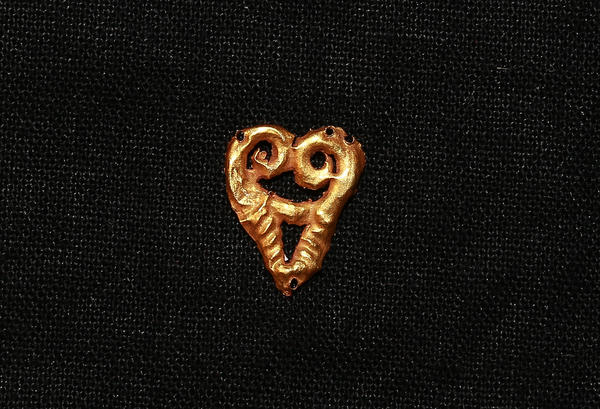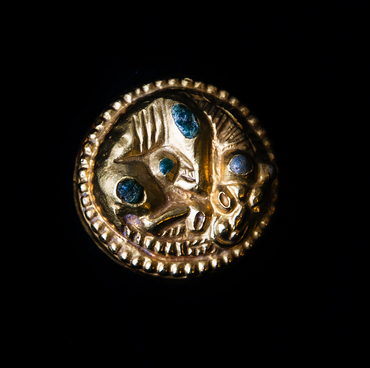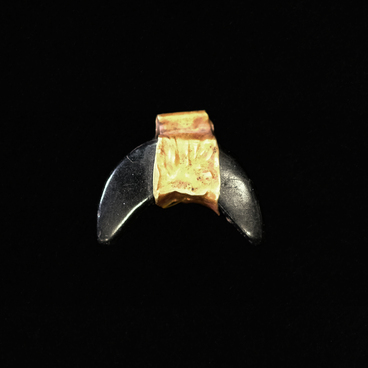The sewn-on appliqué in the shape of a styled ram’s head was found in the BEra mound near the KOsika village in the YenotAyevsky District. This burial was opened and destroyed in 1984, when a water culvert trench was laid there.
Such small formed appliqués are often found in the rich burial mounds of the Sarmatian culture dated from the 1st to the 2nd centures BC. The items adorned with zoomorphic ornaments that depict animals are special. This is a so-called animal style associated with the Sarmatian tribes. Not only appliqués but also horse harnesses, jewelry, buttons, weapons and precious utensils, especially ritual dishes, were ornated with such animal images.
Each animal had its own interpretation behind. The most ‘popular’ were predatory wild cats and graceful hoofed mammals, for example, deer or Asiatic wild asses; birds and horses, fantastic animals and rams are not rare occurences as well. The ram was interpreted as ‘a symbol of heavenly grace’ in the Iranian myths. Nomads revered rams to the same extent as horses, since they satisfied the tribes’ vital needs in the form of: meat, milk, and wool. Rams are outlined symbolically on our appliqués, which is one of the features of the Sarmatian animal style. The bodies are absent on the appliqués, but the heads are depicted clearly to represent the animal image. We can see rounded horns and a triangular muzzle notched to imitate the animal mimic.
Such appliqués were sewn onto the fabric through small holes. Thus, they decorated clothes, hats, ritual objects and burial covers. Researchers suggest that to adorn one thing, various shapes and patterns were used, for example, zoomorphic details alternated with geometric or floral ones. Thus, a set of appliqués from the KOsika village burial mound gives an idea that the appliqués were sewn onto the fabric in a certain order to design various decorative compositions.
In 2005, the sewn-on ram head-shaped appliqués and other precious items were exhibited at the Astrakhan Steppe Treasures show at the National Museum of the Palazzo Venezia in Rome.
Such small formed appliqués are often found in the rich burial mounds of the Sarmatian culture dated from the 1st to the 2nd centures BC. The items adorned with zoomorphic ornaments that depict animals are special. This is a so-called animal style associated with the Sarmatian tribes. Not only appliqués but also horse harnesses, jewelry, buttons, weapons and precious utensils, especially ritual dishes, were ornated with such animal images.
Each animal had its own interpretation behind. The most ‘popular’ were predatory wild cats and graceful hoofed mammals, for example, deer or Asiatic wild asses; birds and horses, fantastic animals and rams are not rare occurences as well. The ram was interpreted as ‘a symbol of heavenly grace’ in the Iranian myths. Nomads revered rams to the same extent as horses, since they satisfied the tribes’ vital needs in the form of: meat, milk, and wool. Rams are outlined symbolically on our appliqués, which is one of the features of the Sarmatian animal style. The bodies are absent on the appliqués, but the heads are depicted clearly to represent the animal image. We can see rounded horns and a triangular muzzle notched to imitate the animal mimic.
Such appliqués were sewn onto the fabric through small holes. Thus, they decorated clothes, hats, ritual objects and burial covers. Researchers suggest that to adorn one thing, various shapes and patterns were used, for example, zoomorphic details alternated with geometric or floral ones. Thus, a set of appliqués from the KOsika village burial mound gives an idea that the appliqués were sewn onto the fabric in a certain order to design various decorative compositions.
In 2005, the sewn-on ram head-shaped appliqués and other precious items were exhibited at the Astrakhan Steppe Treasures show at the National Museum of the Palazzo Venezia in Rome.



